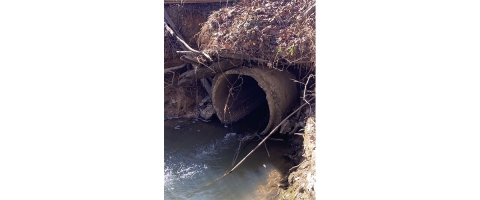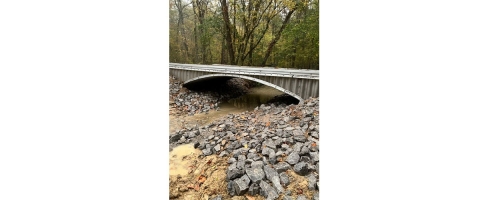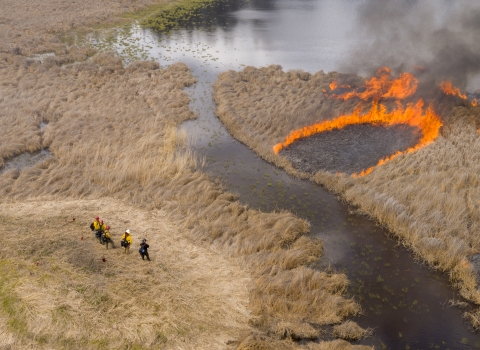Some folks claim Alabama is number one – for many reasons.
Some say it’s because of traditional sports powerhouses’ winning streaks.
Others say it’s because of the unique, one-of-a-kind biodiversity found there.
Nationally – and naturally – ranked No. 1 in aquatic biodiversity by the Alabama Department of Conservation and Natural Resources, Alabama has the most unique species that utilize aquatic habitats. No other state has more species of freshwater fishes, mussels, aquatic snails, or crayfishes. When adding saltwater species to that tally, the numbers only soar.
One team in Alabama is doing its part to protect the biodiversity found in the state. The partnership between Manulife Investment Management and the U.S. Fish and Wildlife Service is a testament to successful, public-private cooperation.
Specifically, Manulife Investment Management and the Service teamed up to restore natural habitats for the federally threatened trispot darter, a small-bodied fish ranging in size from 1.5 to 2 inches. The freshwater fish has been found on land owned by a timber company managed by Manulife Investment Management.
The trispot darter is a migratory species that utilizes distinct breeding and non-breeding habitats. From April through October, the darter inhabits its non-breeding habitat, which consists of the margins of small-to-medium-sized rivers and the lower reaches of tributaries where the water slows. Migration into spawning areas begins in late November or early December. During this time, fish move from the main channels into tributaries, eventually reaching adjacent seepage areas. Here, they congregate for the duration of spawning.
For the last 50 years, the Endangered Species Act (ESA) has helped protect fish, wildlife, and plants listed by the Service as threatened or endangered, including species like the trispot darter. The ESA, which observes its golden anniversary in 2023, outlines how to add and remove species from the threatened and endangered lists; implements plans for their recovery; and allows interagency cooperation.
Both Manulife Investment Management and the Service are committed to conservation and preservation partnerships. Several years ago, the two – along with other partners – teamed up to focus on helping the trispot darter in St. Clair County, Alabama.
“In the process of the sampling, we found opportunities to improve our client’s property, including replacing an old culvert that was left in a stream years ago,” said Robert Colville, Manulife Investment Management’s area forester for Central and East Alabama. “It was rusted and had gotten clogged and rerouted the stream, making a blockage in the stream flow.”
The Bipartisan Infrastructure Law (BIL) is a once-in-a-generation investment in the nation’s infrastructure and economic competitiveness. We were directly appropriated $455 million over five years in BIL funds for programs related to the President’s America the Beautiful initiative.
Learn more about Bipartisan Infrastructure Law replaced an old, undersized, concrete culvert with a bottomless arch structure structure
Something temporarily or permanently constructed, built, or placed; and constructed of natural or manufactured parts including, but not limited to, a building, shed, cabin, porch, bridge, walkway, stair steps, sign, landing, platform, dock, rack, fence, telecommunication device, antennae, fish cleaning table, satellite dish/mount, or well head.
Learn more about structure on private property in St. Clair County, Alabama. The new culvert helps restore the stream to its natural condition and promotes upstream migration for the trispot darter, especially during periods of low water flow. Photo courtesy of Manulife Investment Management
Obsolete or poorly designed structures such as dams, culverts, stream crossings, and levees keep fish and other aquatic species from moving freely to feed, migrate, and reproduce. These challenges put fish populations at risk and undermine the health of rivers by fragmenting aquatic habitats.
Biologists found the trispot darter in three locations on a property belonging to one of Manulife Investment Management’s timber clients. From those surveys and subsequent agreements, the Trispot Darter Cooperative, 3-for-1 Barrier Removal Project came to life. This project includes multiple partners, including private landowners.
One site, located on an unnamed tributary, crossed through the Manulife Investment Management timber area and bordered a private farmer’s property. The road above the old culvert also serves as the main drive to the farmer’s home. It’s also the only real access to the land owned by the private timber management company. The undersized concrete culvert restricted upstream migration to potential spawning habitats for the trispot darter.
The Service used money from the Bipartisan Infrastructure Law to replace the culvert with a bottomless arch structure. The new culvert helps restore the stream to its natural condition and promotes upstream migration for the trispot darter, especially during periods of low water flow.
“The culvert greatly increased the accessibility to the property for sustainable forestry management, and significantly improved habitat for the darters,” said Lee Holt, U.S. Fish and Wildlife Service biologist, who works with the Partners for Fish and Wildlife Program in Alabama.
That’s good news for Manulife Investment Management, its client, and the Service. And it’s very good news for the trispot darter, other wildlife, and the private landowner.
The new culvert complements a larger collaborative effort which includes two other restoration projects on different streams in the same watershed that are also trispot darter habitats.
On one site, a dilapidated corrugated steel culvert will be removed, helping restore the stream to a natural grade which promotes upstream migration. The second site consists of an access road which crosses a stream. Manulife Investment Management agreed to decommission the road, restoring that stream to a natural grade as well.
Manulife Investment Management agreed to take on the other two sites. While these additional projects are close to one another, with just a couple of miles in between, the benefits for the trispot are far-reaching.
Partnerships like this create spaces where private industry, federally listed species, and other wildlife can coexist naturally and in mutually beneficial ways.
“As our first joint project, I was a little apprehensive to work with the federal government, because things can take a while and be very cumbersome, but they made it very easy for us,” Colville said. “There was a lot of behind the scenes work to streamline the process, but it went smoothly, and the project turned out great.”
As an added benefit, biologists also discovered a federally listed mussel – the fine-lined pocketbook. The discovery exemplifies how collaborations can lead to surprising results.
“The type of partnerships we are developing here in St. Clair County, and the trust we share among all partners, can truly be a model for other public-private partnerships, not just in Alabama but throughout the Southeast Region,” Holt said.






